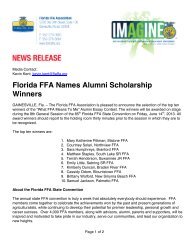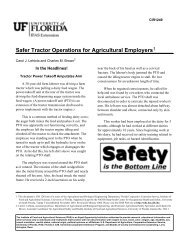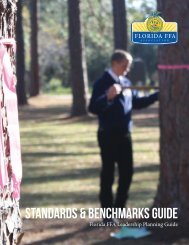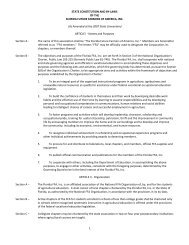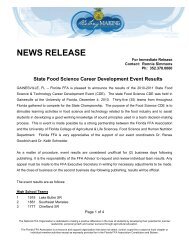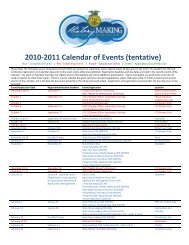CDE Handbook - Florida FFA Association
CDE Handbook - Florida FFA Association
CDE Handbook - Florida FFA Association
You also want an ePaper? Increase the reach of your titles
YUMPU automatically turns print PDFs into web optimized ePapers that Google loves.
Environmental Science and Natural Resources <strong>CDE</strong><br />
54<br />
Environmental and Natural Resources Career Development Event 2012-2016<br />
<strong>Florida</strong> <strong>FFA</strong> Career Development Event <strong>Handbook</strong><br />
Environmental and Natural Resources<br />
Team Activity – Team Presentation – 300 points<br />
State: Team No.:<br />
Oral Communication – 200 points<br />
Indicators<br />
B. Speaking<br />
without<br />
hesitation<br />
C. Tone<br />
E. Speaking<br />
unrehearsed<br />
G. All team<br />
members<br />
participated<br />
Very strong evidence skill is<br />
present<br />
5-4<br />
Speaks very articulately without<br />
hesitation.<br />
• Never has the need for<br />
unnecessary pauses or<br />
hesitation when speaking.<br />
Appropriate tone is consistent.<br />
• Speaks at the right pace to<br />
be clear.<br />
• Pronunciation of words is<br />
very clear and intent is<br />
apparent.<br />
Speaks unrehearsed with comfort<br />
and ease.<br />
• Is able to speak quickly<br />
with organized thoughts<br />
and concise answers.<br />
• All team members took an<br />
active role in the presentation.<br />
Non-verbal communication – 100 points<br />
A. Attention<br />
(eye contact)<br />
B. Mannerisms<br />
C. Gestures<br />
D. Wellpoised<br />
Eye contact constantly used as<br />
an effective connection.<br />
• Constantly looks at the<br />
entire audience (90-100%<br />
of the time).<br />
Does not have distracting mannerisms<br />
that affect effectiveness.<br />
• No nervous habits.<br />
Gestures are purposeful and<br />
effective.<br />
• Hand motions are expressive<br />
and used to emphasize<br />
talking points.<br />
• Great posture (confident)<br />
with positive body language.<br />
Is extremely well-poised.<br />
• Poised and in control at all<br />
times.<br />
Moderate evidence skill is present<br />
3-2<br />
Speaks articulately but sometimes<br />
hesitates.<br />
• Occasionally has the need for<br />
a long pause or moderate<br />
hesitation when speaking.<br />
Appropriate tone is usually consistent.<br />
• Speaks at the right pace most<br />
of the time but shows some<br />
nervousness.<br />
• Pronunciation of words is<br />
usually clear, sometimes<br />
vague.<br />
Speaks unrehearsed mostly with<br />
comfort and ease but sometimes<br />
seems nervous or unsure.<br />
• Is able to speak effectively,<br />
has to stop and think and<br />
sometimes gets off focus.<br />
• Three team members took an<br />
active role in the presentation.<br />
Eye contact is mostly effective and<br />
consistent.<br />
• Mostly looks around the<br />
audience (60-80% of the<br />
time).<br />
Sometimes has distracting mannerisms<br />
that pull from the presentation.<br />
• Sometimes exhibits nervous<br />
habits or ticks.<br />
Usually uses purposeful gestures.<br />
• Hands are sometimes used to<br />
express or emphasize.<br />
• Occasionally slumps; sometimes<br />
negative body language.<br />
Usually is well-poised.<br />
• Poised and in control most of<br />
the time; rarely loses composure.<br />
Strong evidence skill is not<br />
present<br />
1-0<br />
Speaks articulately but frequently<br />
hesitates.<br />
• Frequently hesitates or has<br />
long, awkward pauses while<br />
speaking.<br />
Has difficulty using an appropriate<br />
tone.<br />
• Pace is too fast; nervous.<br />
• Pronunciation of words is<br />
difficult to understand;<br />
unclear.<br />
Shows nervousness or seems<br />
unprepared when speaking unrehearsed.<br />
• Seems to ramble or speaks<br />
before thinking.<br />
• Two or less team members<br />
took an active role in the<br />
presentation.<br />
Eye contact does not always<br />
allow connection with the speaker.<br />
• Occasionally looks at someone<br />
or some groups (less<br />
than 50% of the time).<br />
Has mannerisms that pull from<br />
the effectiveness of the presentation.<br />
• Displays some nervous<br />
habits – fidgets or anxious<br />
ticks.<br />
Occasionally gestures are used<br />
effectively.<br />
• Hands are not used to emphasize<br />
talking points; hand<br />
motions are sometimes<br />
distracting.<br />
• Lacks positive body language;<br />
slumps.<br />
Isn’t always well-poised.<br />
• Sometimes seems to lose<br />
composure.<br />
Points<br />
Earned<br />
Weight Total<br />
Score<br />
X 10<br />
X 10<br />
X 10<br />
X 10<br />
Environmental and Natural Resources Career Development Event 14<br />
X 5<br />
X 5<br />
X 5<br />
X 5<br />
Total Points



